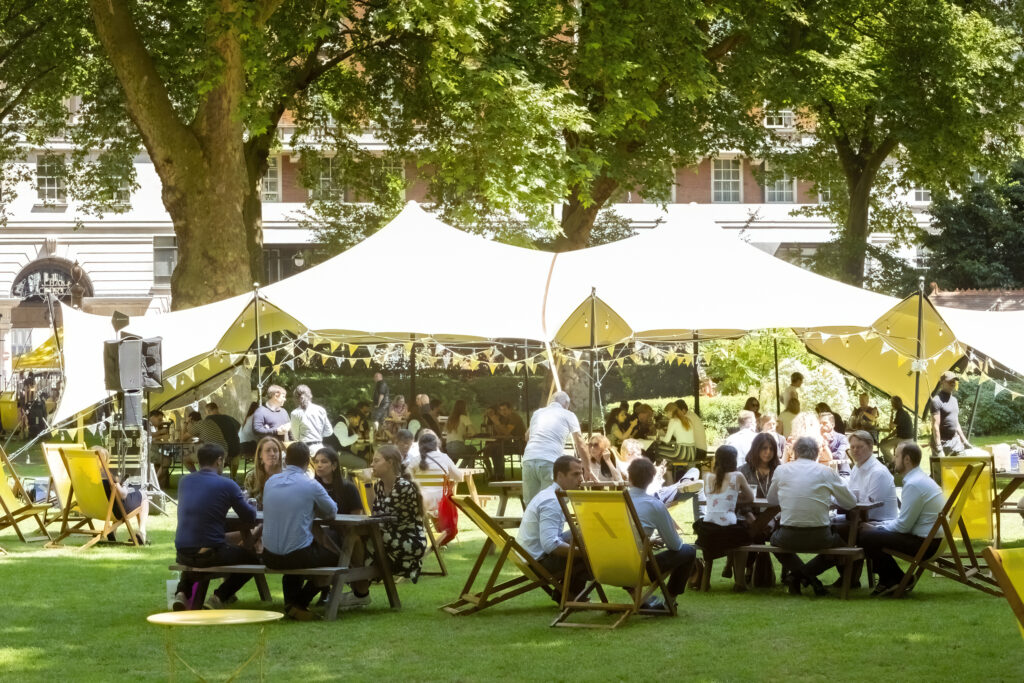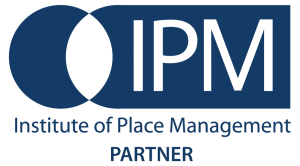The term ‘public realm’ may not be one we use all that often, but the fact is, we spend a huge part of our lives in the spaces that it defines – the spaces which essentially bring us together and make us a community.
We Are Placemaking’s Event Producer Sofia decided to delve into exactly what defines the public realm, and why placemaking is becoming increasingly vital in helping these spaces fulfil their purpose.
What is the meaning of public realm?
Public realm is a term used, often interchangeably with ‘Public Domain’, to identify the urban spaces that are publicly accessible. It encompasses all parts of the built environment that the public has free access to. Areas such as roads, streets, parks, squares, bridges and other open spaces can be included in the public realm, whether in residential, commercial or civil spaces.

But more than just a public space, the public realm can really be a physical manifestation of a community and human interaction outside of the private home. These spaces are essential for people to socialise, play, work, exercise and engage in diverse communal activities.
What is urban planning?
Urban planning is a broader term that encompasses more general areas of a city. It refers to the design and regulation of urban physical spaces which consider economic, social and political concerns. It develops open land and revitalises existing parts of the city with sustainable solutions. The urban public realm consists of typical urban elements of streets, lanes, plazas, parks and other environmental areas.
What is public realm placemaking?
The public realm is essential to society’s lifestyle and human interaction, and this consideration is what shapes the practices of placemaking.

Placemaking is the art of creating and giving a public area a unique character with intentional purpose and smart innovation. Placemaking transforms cities to cater to people and builds communities with the future in mind.
Some examples of Public Realm Placemaking

Examples of our public realm placemaking projects include the Marylebone Summer Festival for the Howard de Walden Estate – an annual event which showcases the best of the village’s shopping and dining facilities, and includes an open-air cinema, a dog show, alfresco bars & dining, live music and various stallholders. Over 200 retailers get involved with the event, making it an exciting and memorable event that really brings the public realm to life.

Public realm placemaking can also promote positive change in society and celebrate diversity and inclusivity. A good example of this is The Pride Wall – a double-feature wall which We Are Placemaking produced for the Northbank BID to celebrate Pride’s 50th anniversary in London. This colourful installation made a great addition to Charing Cross Station, as well as a beautiful backdrop for some fun Instagram snaps. In turn, these images spread the word across social media, increasing awareness and footfall. Most importantly, the activation put a smile on the faces of commuters and celebrated the LGBTQIA+ community. We believe this piece is a true reflection of how powerful creative placemaking in the public realm can be.
Why is placemaking in the public realm so important?
The public realm gives placemakers a special opportunity to bring people together – creating strong and connected neighbourhoods where members of the public can engage with each other and the space they’re in. By utilising placemaking in the public realm, these projects can lead to economic development, improved accessibility, environmental innovations, job growth, increased footfall and stronger engagement with the space.

People have emerged from the pandemic more aware of their environment – prioritising their health and wellbeing, but still eager to find new and exciting experiences around them. It is therefore vital that cities and urban spaces deliver to these consumer needs quickly. In addition, it is crucial that urban development includes sustainability and digital innovation, not only to create compelling reasons for people to return, but also to consider and innovate the future of our cities.
By using placemaking in the public realm, we’re gathering a deeper understanding of the psychology behind public spaces and using it to improve and innovate city living – shaping urban design to have people at its heart. Placemaking can empower the public realm – unleashing huge new potential and encouraging different ways of utilising public space to be explored.
Some Guidelines for Public Realm Placemaking
Sustainability
As placemakers, we want to invest in the future, in a way where we use infrastructures that limit the environmental impact and help to develop a more sustainable public space.
Culture
Culture is such a vital part of any living space, so it’s mandatory that placemaking takes it into account when developing the public realm. Our objective is to enhance these spaces with public art and elevate the cultural realm by establishing and promoting successful and strong cultural partnerships.
Collaboration
By working with a wide range of stakeholders, we are able to cater to a wider audience and test new design solutions. We are committed to developing a strong connection with specialists in different fields which are important to public realm placemaking.
Development
Our expert team creates outstanding events that are driven by our client’s strategies. Considering economic development, outside investment and cultural enrichment is always necessary when planning exciting events in urban areas.
I hope that taking a deeper dive into placemaking in the public realm has given you a deeper understanding of why transforming these spaces is not only important for our wellbeing, social life and personal fulfilment, but crucial for society’s development into a more sustainable and progressive future! With placemaking, these urban spaces that we share and spend so much of our time in provide us and those around us with an opportunity to grow and share incredible experiences as a community.
You can check out more examples of public realm placemaking in our recent projects.





